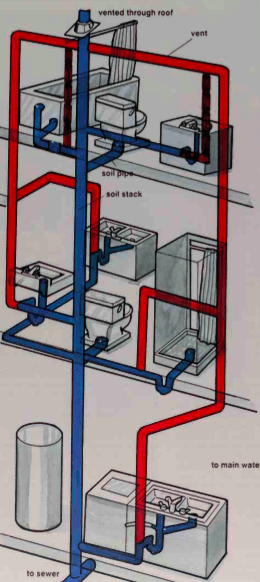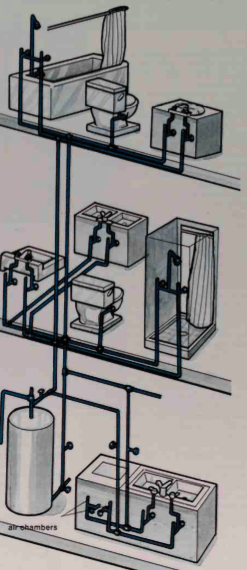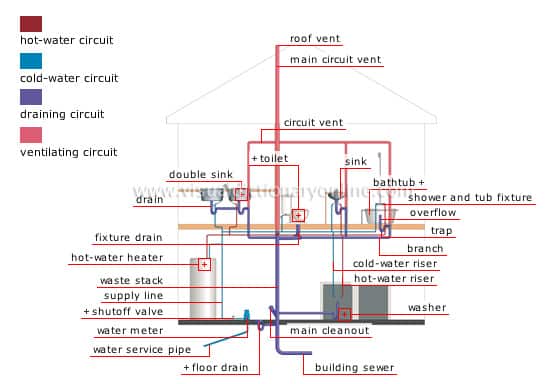How Does Plumbing Work
An understanding of how your plumbing system works makes for easier repairs.
A home plumbing system is made up of three different parts: the water supply lines, the drain-waste-vent (DWV) pipes, and the fixtures.
Water enters your home through a main from a municipal system or a well, and travels to the hot-water heater where the supply line splits into two. One line enters the heater, where it is warmed and returned to a hot-water supply line. The other line is the cold-water supply The hot-water and cold-water supply lines then run parallel to each other from the hot-water heater to the fixtures in the home.
The fixtures are the water control outlets in your house — the bathtub, sinks, toilet, dishwasher or clothes washer. Faucets or electrical controls regulate the amount of water that enters the fixture, while the drain-waste-vent connection on each fixture allows drainage of used water.
The DWV pipes are attached to the bottom of each fixture, allowing water to dram from the fixture into a soil stack, where the waste water is transported to the main house drain and out into the sewer system.
Water enters your house from the municipal water system, a lake or a well, through a 20 or 25mm (3/4 or 1 in) diameter pipe. As it enters the home, it passes through a main shut-off valve. If any plumbing repair work is necessary, this is the valve to close to ensure that no water enters the system while you’re working on it. For localized repair work, shut-off valves are often located near each of the fixtures as well, so that you can shut off the water to a specific fixture without affecting the rest of the water system in the house. Your water meter is usually located next to the main shut-off valve, but may also be found on the exterior of your house or buried in the lawn.
As the water enters the house, it travels through a 2cm (3/4in) pipe directly to the hot-water heater, usually located somewhere in the basement, Before entering the heater, the 2cm (3/4in) pipe is stepped down into two 13mm (1/2in) pipes; one entering the heater, the other becoming the cold-water supply line for the house.
Cola water enters one side of the heater and exits as hot water, usually through a pipe at the top of the heater. This pipe becomes the hot-water supply line. These two pipes then travel throughout the house, parallel to each other and about 15cm (6in) apart, on a direct route to each bathroom, kitchen, laundry room or outdoor faucet. As the pipes travel through the walls they’re known as risers.
A 10 to 12mm (3/8 to 1/4in) diameter pipe, one for the hot water and one for the cold water, leads from the risers to the fixture, with the hot-water pipe on the left and the cold-water pipe on the right.
Every water pipe has a piece of capped pipe attached to it at the spot where it enters the fixture. This capped pipe is called an air chamber. It diminishes hammering in the pipes when the faucet is closed. Since water pressure in your system is at a constant level of about 27kg (60lb), these air chambers absorb the shock created by opening and closing the faucet. The simple act of opening and closing a faucet can build up a pressure of several hundred pounds, and that pressure needs to be absorbed somewhere other than in the water supply pipes. Without these air chambers, enough pressure can build up to burst the pipes
Water pipes are made of steel, copper or plastic, and rarely require any repairs. Metal pipes, however, can become corroded or scaled and need replacing.
Fixtures are durable pieces of equipment that control the flow of water from the water supply pipes to the DWV system. Any repair work necessary on the fixtures would likely be centered around the faucets and clogged drains.
The drain-waste-vent system starts at the drain of your fixture. Waste water is carried from the drain through a tailpipe 3.8cm (1 1/2 in) in diameter to a trap usually directly under the fixture. This trap fills with water when the drainpipe is not in use, to prevent sewer gases from leaking back up into the fixture. After the waste leaves the trap, it travels through a larger pipe to the soil stack. The soil stack is about 10cm (4in) in diameter and runs vertically from the dram in the basement to above the roof line. All drainpipes connect to the soil stack, which in turn expels waste out of the house and into the sewer system.
The top of the soil stack protrudes above the roof to allow enough air pressure buildup in the pipe to give free movement of water through the drain system. This pressure also keeps the waste water from backing up into the fixtures. To keep water moving freely through the entire system, every fixture within a distance of 4.5m (15ft) from the soil stack is vented by a 5cm (2in) diameter pipe to the stack. Fixtures exceeding these distances are separately vented through the roof.
Should a blockage problem be created in the DWV system, there are a series of cleanout plugs m the soil stack and house dram that can be opened to enable you to use an auger to clear the blockage.
DWV SYSTEM
The drain-waste-vent (DWV) system is separate from the water supply system. It removes drain water and waste from fixtures.

WATER SUPPLY SYSTEM

Water enters your home through a mam supply pipe. It travels through a pipe to the hot water heater where it divides into a hot and a cold water supply system.
